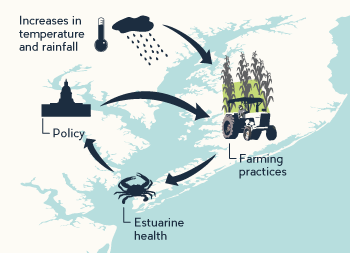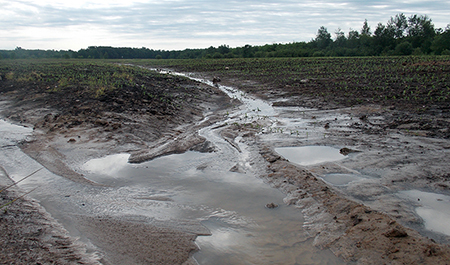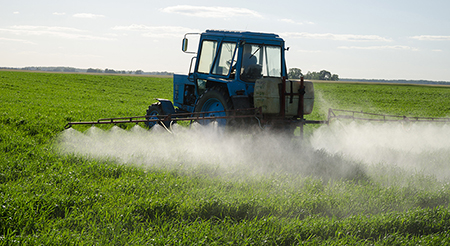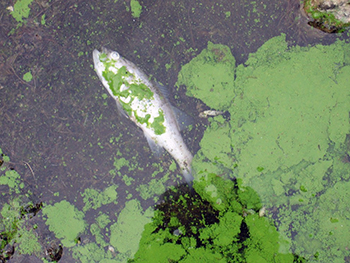How are scientists investigating the effects of climate change on Chesapeake Bay?
 Scientists at University of Maryland Center for Environmental Science (Horn Point Lab and Chesapeake Biological Lab), John’s Hopkins University, Cornell University, and other institutions are collaborating to study how water flow into the Bay will change, how and why farmers will change their practices, how those changes will affect the Chesapeake Bay ecosystem, and what kind of policy changes could lessen the negative impacts on the estuary. They are primarily are using computer models to simulate future climate change effects and how those effects are linked across land, water, and human systems.
Scientists at University of Maryland Center for Environmental Science (Horn Point Lab and Chesapeake Biological Lab), John’s Hopkins University, Cornell University, and other institutions are collaborating to study how water flow into the Bay will change, how and why farmers will change their practices, how those changes will affect the Chesapeake Bay ecosystem, and what kind of policy changes could lessen the negative impacts on the estuary. They are primarily are using computer models to simulate future climate change effects and how those effects are linked across land, water, and human systems.How will precipitation changes affect the amount of nutrients entering the Bay?
 With changes in precipitation, the amount of fresh water and nutrients (nitrogen and phosphorus) entering the Chesapeake Bay will also likely change. Models show that during dry periods, more nitrogen and phosphorus are stored in the watershed. However, nutrient inputs spike during storm events as runoff washes the accumulated nitrogen and phosphorus into the Bay. Increases in the frequency and intensity of storm events could increase the overall amount of nitrogen entering the Bay.
With changes in precipitation, the amount of fresh water and nutrients (nitrogen and phosphorus) entering the Chesapeake Bay will also likely change. Models show that during dry periods, more nitrogen and phosphorus are stored in the watershed. However, nutrient inputs spike during storm events as runoff washes the accumulated nitrogen and phosphorus into the Bay. Increases in the frequency and intensity of storm events could increase the overall amount of nitrogen entering the Bay. How will temperature changes affect agricultural practices?
 In addition, temperature increases have resulted in shorter winters, reduced snow cover, and a decrease in the number of frost days. As these changes intensify, they could (and in some regions, already do) affect agricultural practices. For example, farmers may be able to harvest two crops per growing season, a system known as double cropping. They could also plant their crops and apply fertilizer, which contains nitrogen and phosphorus, earlier in the growing season. As a result, scientists predict that large volumes of nutrients could enter the Bay earlier in the year.
In addition, temperature increases have resulted in shorter winters, reduced snow cover, and a decrease in the number of frost days. As these changes intensify, they could (and in some regions, already do) affect agricultural practices. For example, farmers may be able to harvest two crops per growing season, a system known as double cropping. They could also plant their crops and apply fertilizer, which contains nitrogen and phosphorus, earlier in the growing season. As a result, scientists predict that large volumes of nutrients could enter the Bay earlier in the year.
How do these changes affect the Chesapeake Bay ecosystem?
 These changes may affect the Bay ecosystem because more nutrients fuel algae growth, which causes dead zones, or areas of low oxygen in which few organisms can survive (when algae die and sink to the bottom of the Bay, microbes decompose them and use up oxygen in the process). Furthermore, earlier nutrient delivery could cause the dead zone to appear earlier in the year. Therefore, changes in precipitation and agricultural practices could result in larger dead zones that are present for a greater portion of the year.
These changes may affect the Bay ecosystem because more nutrients fuel algae growth, which causes dead zones, or areas of low oxygen in which few organisms can survive (when algae die and sink to the bottom of the Bay, microbes decompose them and use up oxygen in the process). Furthermore, earlier nutrient delivery could cause the dead zone to appear earlier in the year. Therefore, changes in precipitation and agricultural practices could result in larger dead zones that are present for a greater portion of the year. Policy changes that encourage farmers to decrease the amount of nutrients draining off their land could lessen these negative ecological effects. Research investigating exactly how much precipitation and nutrient inputs could change, how much the dead zone could grow and how long it would persist, and what types of regulations and incentives for farmers would reduce nutrient inputs to the Bay can help guide policy selection. It is important to note, however, that agricultural runoff is only one of many nutrient sources to waterways. Decreasing inputs from other sources, including urban runoff and sewage treatment effluent, also plays an important role in improving the health of estuaries. This case study demonstrates the importance of thinking about natural and human systems and the linkages between them as an interconnected whole rather than distinct, separate parts.



